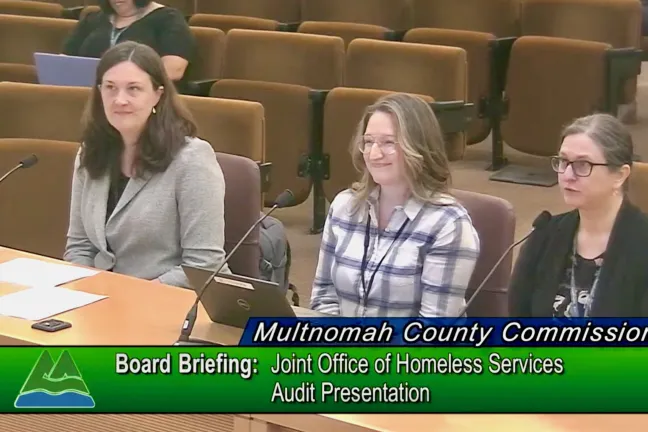On Tuesday, April 23, 2024, the Multnomah County Board of Commissioners received a briefing from the County Auditor’s office on their recent report that showed that the Joint Office of Homeless Services’ housing placement data is accurate 96% of the time.
The report also outlined some barriers and shortcomings of the current Homeless Management Information System, validating the Joint Office’s ongoing work to update that system. The report’s focus was different from a 2023 report from the Auditor’s office focused on Joint Office contract management.
For their report, the office of Auditor Jennifer McGuirk focused on evaluating the accuracy of the Joint Office’s housing placement data. That data tracks how many people each year move from homelessness to housing with Joint Office funding, as well as what kind of housing programs they are enrolled in. For their evaluation, the Auditor’s office compared data from a sample of 11 homeless services providers to the Joint Office’s data, analyzing whether the data was consistent.
“What we found in our sample is that in 96% of cases, the Joint Office’s data was an accurate reflection of the provider's data. Those were excellent results,” said Nicole Dewees, Audit Director.
The auditors also confirmed that the Joint Office is now tracking housing placement data using move-in dates, not program start dates. Previously, the Joint Office used project start date as a proxy for move-in date due to limitations in the HMIS system. After Joint Office staff realized that this was not sufficient and was leading to inaccuracies in placement data, and after the federal government updated its guidance for communities nationwide, the department began developing a way to track move-in dates as a way to measure placements. The urgent need to improve placement data was underscored in a
in line with those previously established plans.
“We were pleased to find that the Joint Office is now using the housing move-in date for reporting housing placements,” Dewees said. “We looked at Fiscal Year 2023 and found they were using the field correctly.”
The auditor’s office identified some ongoing barriers to data use, namely the challenges associated with the current Homeless Management Information System (HMIS) — the federally required data system that collects client and program data from local homelessness and housing service providers. Auditors confirmed that the system is difficult to use and that many providers input data into a second data system in addition to HMIS.
“We found that duplicate data systems increase the risk of data inaccuracy, and they're inefficient,” said Mandi Hood, Management Auditor.
The report recommends implementing a database compatible with an application programming interface, or API, a software that allows two applications to “talk” to each other. An HMIS system with that capability would allow homeless service providers to upload data into HMIS directly from their internal systems, instead of entering that data multiple times in different programs.
Representatives from the Joint Office said improvements like that will now be possible, thanks to a recent transfer of the HMIS system from the Portland Housing Bureau to the Joint Office.
“While the transfer of the HMIS system to Multnomah County does not entail noticeable changes to the software, it sets the foundation for key projects and initiatives to move forward,” Chair Jessica Vega Pederson said. “Now that we have the HMIS in-house, we control the data and have the ability to make the changes needed to be responsive in the field to meet our goals and serve the community.”
The Joint Office and County Information Technology are already in the early stages of procuring a new HMIS vendor that would serve the entire tri-county region. That process will take a few years due to the size and complexity of the system and the number of jurisdictions and partners involved, including Washington and Clackamas counties. In the meantime, the Joint Office will be able to make improvements to the system that weren’t possible before — including improved reporting and dashboards and the capacity for quicker data analysis.
The Joint Office has been working through a data modernization and improvement plan, using best practices that have proved successful in the healthcare and public health sectors. That includes adding data staff capacity, building a by-name list of people experiencing chronic homelessness in close partnership with the Built for Zero initiative, and conducting ongoing data quality assurance work.
“We have interim solutions,” said Anna Plumb, Joint Office deputy director. “The fact that we have control over HMIS means that we can design and build a datamart, something we can layer over the current HMIS system to allow us to get data out in a streamlined, effective way.”

